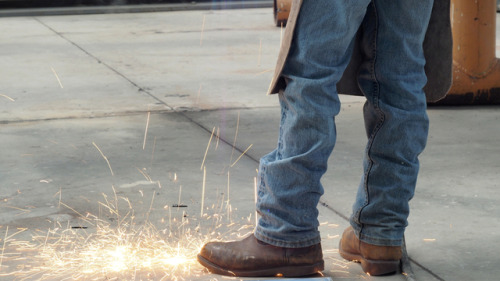HOW TO CHOOSE THE RIGHT WELDING BOOTSWelding in itself is a very...

HOW TO CHOOSE THE RIGHT WELDING BOOTS
Welding in itself is a very dangerous activity. Hence, you are more exposed to the risk inherent in welding without the appropriate safety boots. While wearing welding boots cold feel a little uncomfortable at first, it does a very good job of protecting the leg.
Below are some dangers to your feet when welding without a safety boot:
- Injuries and burn as a result of flying sparks
- Splatter from welding materials, irritating liquids or molten metals could cause injury
- Risk of stepping on an electric wire or sharp object
- Electric shock
- Risk of the object penetrating the sole of your feet
- Fall and slippage as a result of wet floor etc.
With the above in mind, it is obvious that the main reason for selecting a good safety boot is safety. Thus, you get to protect your leg and toes from injuries that could otherwise be deadly.
Looking at the dangers involved in not using a welding boot, it is a big risk not to use one as a welder. You just don’t go to the market and select a welding boot that appeals to you.
There are many things to be considered when choosing a welding boot. While I don’t trivialize aesthetics and design, comfort, ease of movement, materials etc are the factors that you should consider when selecting the right welding boot for you.
Key features to Consider When Choosing Safety Boots1. Heat Resistant Material
Welding is a hot job that required continuous exposure to very high temperatures. Asides, irrespective of the type of welding you are operating, heat will always be involved.
In this regards, it is important to consider leather, as it is one of the most common heat resistant material. Hence, a leather made welding boot keeps your feet secured against extreme temperatures and some of the hazards described above like sparks, molten metal, and electric shock.
Also, leather materials are often resistant to water and other corrosive materials.
2. Slip-On or Lace-Up Design
Majorly, there are two basic welding boots design: the slip on and the lace-up design,
The lace-up design:
The lace-up boots give a more comfortable fit. With the lace, the tightness of the welding boot can be adjusted to give a secure and comfortable fit.
One con about welding boots with lace design is the risk of the lace catching fire from sparks. Asides, the lace makes removing the welding boot quite tedious.
If you prefer a welding boot with a lace design, I recommend that you opt for boots with leather guards to cover the lace. This reduces the risk of catching fire from sparks.
The Slip-on Boot
These slip-on boots do rise up the calves, giving more protection. Due to the absence of slip, it is very easy to put on and remove. Asides, the risk of the lace catching fire is off the table.
The downside is that it is not as comfortable as the lace up design.
3. Shock Resistance
In welding, you have to deal directly with electrical equipment. In other words, there could be wires on the floor with the risk of accidentally stepping on a naked wire. Asides that, there could be static discharges on conductive materials and metals which could lead to an electric shock.
With this in mind, I recommend choosing a welding booth that is resistant to shock. The best welding boot in this category is those with rubber outsoles. Most of them can withstand electric shocks up to a thousand volt.
4. Safety Toes
Welding in itself is a pretty dangerous exercise and so is the welding environment. As a result, having the best welding boots on is not negotiable. When classifying welding boots based on safety toes, there are three major types. These are the steel, composite and aluminum.
Worthy of note is that these varieties all satisfy the ASTM protection. Your choice is a factor of your personal taste and your specific working environment. I discuss the types below:
- Steel toes: of all the three types, these are considered to be the heaviest. Steel toe caps are the basic choice for protection and can conduct temperature better than other options. There are new designs that improve the comfort and fit. I also recommend that you go with a steel toe cap that is light without sacrificing safety.
- Aluminum toes: Aluminum toes can be said to be the most comfortable option. It is thicker than the steel toe type yet meets the ASTM safety requirement. They are recommended for welders who prefer a light welding boot.
- Composite Toes: While complying with ASTM safety standards, the best composite toes shoes are usually made of Kevlar, plastic or carbon fibers. It is the thickest of the three options and of course, lighter than the steel toe. Since it is non-metallic, it doesn’t transmit heat or electricity and also offers electrical safety
- Your choice when considering a safety boot is your personal preference and working condition. Should you be in an environment with the possibility of flying objects around, the steel toes option is recommended. But, if you don’t want to sacrifice comfort, I recommend the composite toe.
Read more from: Welding Rodeo AZ
via weldingrodeo.com
Nhận xét
Đăng nhận xét